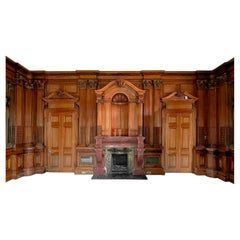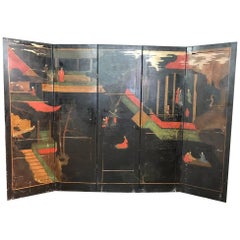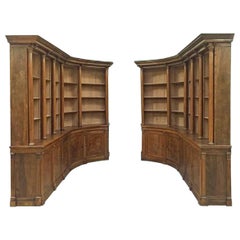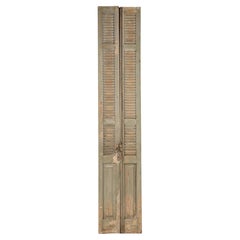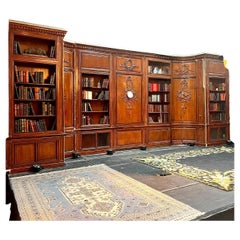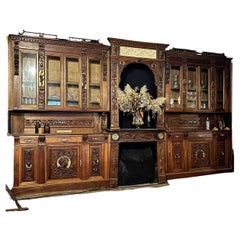19th Century Panelling
to
10
44
38
85
Height
to
Width
to
11
4
3
2
2
2
1
1
1
1
1
1
40
85
93
85
35
33
9
8
1
3
4
3
16
2
3
3
1
71
20
12
7
6
56
25
14
12
10
85
85
85
Period: 19th Century
George Trollope & Sons fireplace & room, Paris Exhibition 1878 Gold Medal Winner
Located in London, GB
George Trollope and Sons. Exhibited at the Paris Universal Exhibition in 1878 winning a Gold Medal for Excellence.
The set forms the four sides of a complete panelled room that was exhibited as a boudoir room or petit salon at the Paris Exhibition 1878 .
The main feature and centrepiece of this boudoir room is the Rosso Antico marble fireplace surmounted by an open display niche carved in cedar wood.
Each side of the room is composed of various panels and are as follows:
One side with a grand Rosso Antico marble fireplace flanked by two doorways.
One side with French doors originally opening onto a balcony, flanked by two large bookshelves.
One side with a window flanked by two mirrors. The opposite side with three large mirrors.
The complete room measures:
21 ft / 6.4 m wide, 17 ft / 5.18 m deep, and 12 ft / 3.65 m high.
It could also be used in a number of different combinations to suit various room layouts. The mirrors could be replaced with windows or further bookcases.
Each side is decorated with various sizes of finely carved panels and holds ornate Corinthian style columns surmounted with cherubim's on the capitals. Three cherubs are formed at the top of each corner with three columns, at the column bases there are circular carved pedestals to display statues.
Published & illustrated in the ‘Illustrated Catalogue of the Paris International Exhibition’.
The main part of this room, the Rosso Antico marble fireplace is surmounted by a large open display niche carved in cedar wood are illustrated with a line drawing in the Paris Universal Exhibition catalogue on page 209. The whereabouts of the seminaked caryatids and the marble bust of Alexander Pope are unknown. The bust of Alexander Pope was copied from the original one in Westminster Abbey, London.
The Corinthian columns now flanking the niche above the fireplace are also in cedar wood having the identical carved fluting to the rest of the room and were made to replace the caryatid figures. Those Corinthian columns are period to the room and can only have been made shortly after it arrived back to London and before it was reassembled and fitted into the house built by George Trollope and Sons in the 1880's, and where we removed it all from.
George Trollope made clever use of Alexander Pope's early 18th-century poetical successes in Great Britain and France by using ‘The Rape of Lock’, a mock-heroic narrative poem Pope wrote in 1712 about Petre who cut off a lock of Arabella’s hair without her permission, as the theme of the boudoir room or petit salon at the 1878 Paris Exhibition.
In the original exhibition display of the room set, tapestries depicting the Rape of Lock were hung where the mirrors are now positioned.
Alexander Pope's The Rape of the Lock is a humorous indictment of the vanities and idleness of 18th-century high society. Basing his poem on an actual incident among two families of his acquaintance, Pope intended his verses to quench hot tempers and to encourage his friends to laugh at their own foolishness.
The poem is an outstanding example in the English language of the genre of mock-epic. The 'epic' was considered one of the most serious of literary forms; it had been applied, in the classical period, to the trivialities of love and war. Pope’s mock-epic is not to mock the form itself, but to mock his society in its very failure to rise to epic standards, exposing its pettiness by casting it against the grandeur of the traditional epic subjects and the bravery and fortitude of epic heroes: Pope’s mock-heroic treatment in The Rape of the Lock underlines the ridiculousness of a society in which values have lost all proportion, and the trivial is handled with the gravity and solemnity that ought to be accorded to truly important issues. The 18th-century society in this poem fails to distinguish between things that are important and things that are not. The poem mocks the men it portrays by representing them as unworthy of a heroic culture. Therefore the mock-epic follows the epic in that its main concerns are serious and moral. The point that the theme must now be satirical rather than earnest is symptomatic of how far the culture has fallen.
Retaining the original exhibition label
The back of the panelling still retains two original labels printed with the 'Union Jack' and printed adjacent to it, 'The Secretary Royal British Commission for the Universal Exhibition 1878 Champ de Mars Paris'.
Adjacent to that and below, printed and written in ink vertically:
Exhibitor: (and signed in ink) George Trollope & Sons.
Address: (written in ink) Halkin Street West. London.
Allotment in Block: (written in ink) a2. In the printed floor plan 'a2 square' is in the very first line to the right of the floor plan and handwritten in ink with a 'diamond shape' also written with '101' within it. This pin points where George Trollope's stand was located.
With thousands of items being displayed at the Exhibition, this label would have been the floor plan for the craftsmen, so they knew the correct place to install the boudoir room or petit salon.
The firm continued expanding house building and interior decoration side of the business and by 1849 was also trading as an estate agency, letting and controlling property for the Grosvenor Estates. A separate branch of cabinet-makers, bearing the family name, was opened at West Halkin Street, London. becoming known as 'The Museum of Decorative Arts' (looked after by George Robinson). Here Trollope and Sons also sold high-class antique furniture made by other makers. In 1851, the firm became formally known as George Trollope and Sons. West Halkin Street, London. The address was recorded in the listing for the firm in The Furniture Gazette Directory, 1876 & 1877.
Period Press Coverage & Art Critic Review.
everal newspapers also thoroughly describe George Trollope and Son's stand including the different tapestries that were hung where the mirrors are now, illustrating the poem 'The Rape of Lock', by Alexander Pope.
Marius Vachon, a French Art Critic and journalist, who wrote for the journal ‘La France’ published an extensive review of the Trollope and Sons stand in a book called Les Merveilles de l'Exposition de 1878 (The Wonders of the 1878 Exhibition).
Note: In the World Fairs translation it states door frame, Marius Vachon had originally written ‘chambranle’ in French, 'chambranle' loosely translates to a frame around something, and should read in its correct context: ‘fireplace in rosso antico’.
We have taken the extract below written by Marius Vachon in its translated form from: Les Merveilles de l'Exposition de 1878, (The Wonders of the 1878 Exhibition). This puts into perspective the importance of this fine quality room interior when he viewed it at the exhibition in 1878:
Marius Vachon: English furniture is very curious to observe; irreproachable from the point of view of execution, the furniture of our neighbours always reaches the last degree of respectability and comfort. One thing to be noticed is that for large pieces of furniture, the English upholsterer is transformed into a sort of architect; everything he makes takes on a monumental aspect.
The first object that catches the eye when one enters the furniture class is the beautiful boudoir-salon exhibited by Mr. Trollope. The boudoir (or petit salon), of carved cedar wood, is an attempt to reproduce the style which prevailed in England during the first decade of Queen Anne's reign, and all the details have been studied, but not copied, from examples of decorative work of the time. The fireplace is in "rosso antico" movement, and the ceiling is in portable plaster. The panels painted on canvas represent scenes from the heroic-comic poem "The Abduction of the Hairpin," (The Rape of Lock) written by Alexander Pope in 1712, the eighth year of Queen Anne's reign, in which the customs and mores of the time are satirized in a pleasing manner.
The apotheosis of the Loop and its sidereal transformations will form the decoration of the ceiling. In these illustrations of Pope's charming poem, the costumes and accessories have been taken from models of the time; and the bust of the poet, copied from his tomb in Westminster Abbey, occupies the niche in the centre of the mantelpiece.
M. Marius Vachon, the period writer of the above continues with:
Now we shall mention at random the magnificent dining table of Messrs. Johnston and Co., their oak mantelpiece, their boudoir table; Mr. Watt's drawing-room mantelpiece stepped in the old style and imitating the Japanese; Mr. James Shoolbred's great
The Decorative Arts Society on Trollope and Sons
The boudoir or petit salon is mentioned again in the Decorative Arts Society:
Trollope did not exhibit such highly rated objects at the 1878 Paris Exhibition as at previous exhibitions; items included a large mirror frame carved in limewood in Renaissance style and a satinwood cabinet in Adam revival style, with a similar armchair (illus. Meyer (2006), p. 242) and probably two rooms; one was a boudoir in cedar wood in Queen Anne style and the other was a boudoir decorated by the firm in the theme of Pope’s The Rape of Lock.
In the above extract, it is quite clear that the two rooms mentioned are in fact the very same room, because the fireplace and niche are illustrated in The Paris Universal Exhibition catalogue on page 209 and Marius Vachon describes the rest of the room set in the above…
Trollope and Sons exhibition pieces listed and described by Meyer in an article he wrote for: The Decorative Arts Society 1850 to present, Journal 25 in 2001., where he points out the importance of George Trollope and Sons and mentions a table by Trollope exhibited at the 1867 exhibition that sold for £40,000 in 1996. He also mentions a cabinet exhibited by Trollope at the International Exhibition of 1862 that sold at Sotheby's in 1997 for £150,000.
Interest was not as strong in the 1990's as it is today for rare exhibition pieces, high quality items were abundant back then, it was a golden era when the most beautiful works of art just kept coming onto the market. But there are exceptions as in this instance, when a unique, gold medal-winning exhibition work of art comes onto the market for the very first time.
Meyer continued researching and writing about the great exhibitions and released his book in 2006, 'The Great Exhibitions, London, New York, Paris and Philadelphia 1851- 1900, where he mentions only in passing, The Boudoir Room or Petite Salon exhibited by Trollope, he even states that an image was not reproduced and that Trollope's exhibits in 1878 were not up to the quality and class of the items Trollope exhibited in London in 1862 and Paris in 1868. This is probably because Meyer didn't know of the line drawing illustrating the Roso Antico Fireplace, Niche and Panelling reproduced in The Illustrated Catalogue of the Paris International Exhibition 1878 shown in the above which Geering recently uncovered.
John Meyer continues in the DAS journal:
Undoubtedly they (Trollope) are a firm worthy of further research as they were right at the forefront of the furniture business in London from 1860 to 1880.
Our research shows that the Petite Boudoir was awarded the gold medal for excellence in 1878 (see Journal La Liberté 23-10-1878 with the list of all medals attributed), something George Trollope and Sons did not achieve at the London 1862 and the Paris 1867 exhibitions. Jonathan Meyer joined Bonham's in 1977. He was Director at Sotheby's in charge of 19th Century Furniture from 1994 to June 2007. He was also chairman of the Fine Arts Faculty for The Royal Institute of Chartered Surveyors.
In the original description from the article in Les Merveilles de l’exposition de 1878, M. Marius Vachon states:
The first object that catches the eye when one enters the (English) furniture class is the beautiful boudoir-salon exhibited by Mr. Trollope.
Suggesting, it was in his opinion the very best on display in the English section, and being awarded the gold medal for excellence can only add weight to this.
Adjacent to the original label that was printed by The Secretary - Royal British Commission for the Universal Exhibition 1878 in stencil ‘TO BE KEPT’, i.e. ‘to be returned’. This confirms why it came back to London. We removed the Boudoir Room or Petite Salon from a Trollope house, part of a grand high-class housing estate in London which around the time of the exhibition Trollope and Sons were in the process of building, and where the room set was installed directly after it returned from the exhibition in 1878 until now.
Worthy of note is the machines that did the carving for the Boudoir Room or Petite Salon and also did all of the decorative carving (most of which was linenfold carving) for the Houses of Parliament, London.
This machine, the engraving and description of which we copy from Engineering, was specially designed by its inventor, Mr. Jordan, for assisting in the production of the vast amount of carved decorations required for the walls and ceilings of the Houses of Parliament, London, and it was so employed during the entire progress of the work. The late Sir Charles Barry was so well satisfied with it, that he frequently declared it would have been impossible to have accomplished the work without it. The Department of Woods and Forests employed five of the machines at the Government Works, Thames Bank, for several years; and the machines have now passed into the hands of Messrs. George Trollope and Son, and are still used in the same building.
They also exhibited the new technique of xylatechnography and sgraffito, methods of impressing coloured design into soft wood and engraving veneer to reveal the base wood.
The newspaper, La Liberte October, 23rd 1878 listing the medal winners of the Paris 1878 exhibition. Third column, ''GROUPE III MOBILIER ET ACCESSOIRES'', (GROUP III FURNITURE AND ACCESSORIES). Medailles d'or. (Gold Medals) where G Trollope et fils (G Trollope and Sons...
Category
Antique 19th Century Panelling
Materials
Marble
Double Sided Coromandel Chinoiserie Lacquer Five-Panel Screen, Paravent, 1890s
By Jean Dunand
Located in Biebergemund, Hessen
Exceptional double sided Chinoiserie hand-painted Coromandel screen, with a continuous scene over the panels. One side depicts a scene of the Forbidden City, and the other side shows...
Category
French Chinoiserie Antique 19th Century Panelling
Materials
Wood, Hardwood
19th Century Walnut Pair of Bookcases Boiserie de Bibliothèque
Located in Vosselaar, BE
A rare pair of heliocodal French Directoire library bookcases in solid walnut. This type of bookcases is also known as 'boiseries de Bibliothèque' a...
Category
French Empire Antique 19th Century Panelling
Materials
Walnut
Pair of Antique French Shutter in Old Crumbly Paint From a Chateau in Brittany
Located in BENSENVILLE, IL
Antique pair of French shutters in very old paint removed a long time ago from a chateau located in Brittany.
**Width provided is for the wider shutte...
Category
French Country Antique 19th Century Panelling
Materials
Wood, Paint
Louis XVI style woodwork 16m linear
Located in TOURCOING, FR
Monumental Louis XVI Style Boiserie – 16 Linear Meters
A rare and exceptional Louis XVI style wood paneling ensemble, spanning an impressive 16 meters in length and 3.55 meters in h...
Category
French Louis XVI Antique 19th Century Panelling
Materials
Wood
$28,714 / item
Louis XIII-style Norman walnut and gilded library woodwork
Located in TOURCOING, FR
Norman Louis XIII Style Walnut and Gilt Library Paneling
Origin: France
Period: Late 19th – Early 20th Century
Style: Louis XIII
Materials: Solid walnut with gilt details
De...
Category
French Louis XIII Antique 19th Century Panelling
Materials
Walnut, Giltwood
Reclaimed 19th century French Provincial Boiserie Panel
Located in Mckinney, TX
A striking mid-19th century French boiserie panel with original pale olive green paint, delicately worn over time to reveal subtle undertones beneath.
The carved frame features gra...
Category
French French Provincial Antique 19th Century Panelling
Materials
Wood
Neo-Gothic Flemish hand carved panel in solid oak, ca. 1850
Located in Meulebeke, BE
Belgium / 1850 / panel / oak / Neo-Gothic / Antique
Highly decorative 19th century Flemish panel with hand carved Neo-Gothic decorations in oak. The panel consist of four rectangle ...
Category
Belgian Gothic Revival Antique 19th Century Panelling
Materials
Oak
Set of Two Large French 19th Century Curved Hand Carved Walnut Panels
Located in Santa Monica, CA
Set of two large French 19th century curved hand carved walnut panels.
Category
French Antique 19th Century Panelling
Materials
Walnut
$1,438 Sale Price / set
40% Off
Antique 19th Century Oak and Elm Panelling Panelled Room - 7 Panels
Located in Ware, GB
This antique panelling was reclaimed as a whole room and is comprised of Oak and Elm.
There are 7 panels altogether, sizes of each listed below. The panels can be reconfigured/cut t...
Category
British Antique 19th Century Panelling
Materials
Wood, Elm, Oak
19th c. Chicago Stock Exchange Building Molding Fragment Architectural Element
Located in Forney, TX
A rare and important hand painted plaster decorative molding fragment, by Louis H. Sullivan (American, 1856-1924), from the interior of the Chicago Stock Exchange, circa 1893-1894.
...
Category
American Industrial Antique 19th Century Panelling
Materials
Plaster, Paint
Important Monumental Italian Church Altar Frontal Antependium
Located in Forney, TX
A magnificent Italian church antependium altar frontal, acquired from the estate of the iconic American oil tycoon, T. Boone Pickens. The last photo show...
Category
Antique 19th Century Panelling
Materials
Fabric, Wood
French Regence Oak Paneled Room
Located in Queens, NY
Thirty-two French Régence style (19th Century) oak paneled room with trophy carving. Approximately 50 running feet. Individual panel measurements: 29...
Category
French Régence Antique 19th Century Panelling
Materials
Oak
$240,000 / set
2 Antique Eastlake Victorian Architectural Salvage Molding Panels Column Pillar
Located in Dayton, OH
Pair of victorian eastlake architectural moldings. Features a sawtooth block leading to corbel and long fluted panel.
Category
Eastlake Antique 19th Century Panelling
Materials
Hardwood
$720 Sale Price / set
20% Off
Antique 19th Century French Chateau Oak Paneled Salon Room "Boiserie" circa 1865
Located in New Orleans, LA
A complete boiseries from the French country estate: "Chateau de Quatres Barbes." The antique 19th century French Louis XVI style grand oak paneled salon room...
Category
French Louis XVI Antique 19th Century Panelling
Materials
Marble
Early 19th Century Reclaimed French Blue Curved Corner Boiserie Panel
Located in Mckinney, TX
A rare and sculptural early 19th-century French boiserie panel, salvaged from a historic chateau in the countryside. Designed to fit into a curved corner, this wooden architectural f...
Category
French Antique 19th Century Panelling
Materials
Wood
11m Run of Full Height Reclaimed Oak Wall Panelling
Located in Wormelow, Herefordshire
A 11m run of full height reclaimed oak wall panelling with a handsome dark wood patina, sourced from a period building in London.
Dating from the early 20th century, this set of sol...
Category
English Edwardian Antique 19th Century Panelling
Materials
Oak
Large antique carved oak wood paneled room
Located in SAINT-OUEN-SUR-SEINE, FR
This beautiful carved oak wood paneled room was made in the 19th century.
Designed originally for a hexagonal room, with a boudoir, it is composed of six carved wall panels. Three panels have window openings, two are fitted with doors, and the last panel has a large overmantel mirror .
The harmony of these elements is ensured by a bucolic decoration of grapes and hunting and fishing trophies...
Category
French Napoleon III Antique 19th Century Panelling
Materials
Wood, Oak
Louis XVI Style Panelling with Fireplace and a Marine Scene, Oil on Canvas
Located in SAINT-OUEN-SUR-SEINE, FR
This paneled room is composed of a stone fireplace, a large glass door with four leaves, a single door (both with their frame) and a large oil on canv...
Category
French Louis XVI Antique 19th Century Panelling
Materials
Stone
Antique French Neoclassical Grisaille Overdoor Painting, Circa 1815
Located in Dallas, TX
Hand-painted in France, this handsome grisaille overdoor painting is from the neoclassical period, circa 1815. Grisaille is a monochromatic painting ...
Category
French Neoclassical Antique 19th Century Panelling
Materials
Canvas
Louis XV style oak paneling and bookcase including a fireplace mantel.
Located in SAINT-OUEN-SUR-SEINE, FR
Louis XV style oak paneling and bookcase, including an elegant direplace mantel
Category
French Louis XV Antique 19th Century Panelling
Materials
Oak
Set of Four 19th Century Japanese Lattice Wooden Panels
Located in Los Angeles, CA
Set of four 19th century stunning, intricate lattice panels from Japan. Wood with naturally worn patina; traces of crackled finish. Each panel measures 35.5 inches wide and placed to...
Category
Japanese Edo Antique 19th Century Panelling
Materials
Wood
$9,990 Sale Price
33% Off
19th Century Indian Carved Panel with Shutter Windows
Located in Rio Vista, CA
Fantastic 19th century Indian wall panel with two sets of shutter windows. Features a highly carved front with a blossom or starburst motif. On top a...
Category
Indian Anglo-Indian Antique 19th Century Panelling
Materials
Brass
Large Antique Oak Wall Panel
Located in Wormelow, Herefordshire
A single large antique oak wall panel salvaged from a British church. It dates from the early 1900s during the Victorian era and features solid oak construction with a rich warm wood...
Category
English Victorian Antique 19th Century Panelling
Materials
Wood, Oak
19th Century, Monumental Carved Boiserie Panels from Lartington Hall
Located in London, GB
The Lartington hall carved Boiserie panels
by Signor Anton Leone Bulletti.
A highly important suite of eight carved and patinated wood panels commi...
Category
English Renaissance Revival Antique 19th Century Panelling
Materials
Wood, Pine
19th Century Antique Chinese Handcraft 5 Panels Wooden Screen / Room Divider
Located in Pomona, CA
Size: 115 1/2"H x 19 1/2"W x 2"D each
All together: 97 in W
Origin: Shan Xi, China
Circa: 1850
Material: Elm wood
Condition: Original finished, very good condition. hand made, hand ...
Category
Chinese Chinese Export Antique 19th Century Panelling
Materials
Elm
Set of 3 English Renaissance Leaded Glass Windows
Located in Queens, NY
Set of 3 English Renaissance style (19th Century) leaded glass window panels with diamond design and figure in center (PRICED AS SET).
Category
English Renaissance Antique 19th Century Panelling
Materials
Wood, Glass
$16,500 / set
Pair of English Renaissance Style Carved Walnut Panels
Located in Queens, NY
Pair of English Renaissance style (19th Century) walnut carved wall panels (PRICED AS Pair).
Category
Renaissance Antique 19th Century Panelling
Materials
Walnut
Qing Dynasty Chinese Four Panel Screen c. 1850
Located in Jimbaran, Bali
A testement to Qing Dynasty craftsmanship this folding panel features wonderful lattice windows. The panel still features its original hinges that allows for many ways to position th...
Category
Chinese Qing Antique 19th Century Panelling
Materials
Wood
Antique Door, Lacquered Baroque Motif and Carved Lozenge, 19th Century Italy
Located in Cuneo, Italy (CN)
Ancient single interior door, hand-painted with a very swirling baroque motif and hand-sculpted with lozenge, smooth back as they embellished only a part of the house, built in the m...
Category
Italian Antique 19th Century Panelling
Materials
Wood
$3,062 Sale Price
20% Off
Anglo Indian Painted Doors in Original Frame, Wall Art
Located in Godshill, Isle of Wight
Anglo Indian Painted Doors in Original Frame, Wall Art
These beautiful wooden doors would look fabulous on a wall as decoration or relocated in ...
Category
Anglo-Indian Antique 19th Century Panelling
Materials
Paint
Pair of English Gothic Revival Oak Railings
Located in Queens, NY
Pair of English Gothic Revival style (19th Century) oak carved railing panels with open design and finial (PRICED AS Pair).
Category
British Gothic Revival Antique 19th Century Panelling
Materials
Oak
$7,500 / set
Late 19th Century French Art Nouveau Double Doors, Set of 3
Located in Dusseldorf, DE
Rare set consisting of 3 identical French Art Nouveau double doors from around 1900. Unrestored condition.
Solidly made of pine wood in frame construction with 3 panels each and p...
Category
French Art Nouveau Antique 19th Century Panelling
Materials
Pine
4 Stained Glass of Painter of the Flemish Renaissance and Their Painting
Located in Brussels, Brussels
- Magnificent set of 4 windows of the 19th century representing the great painters of the Flemish Renaissance.
At the top of each stained-glass window are men playing guitar, smokin...
Category
Belgian Renaissance Antique 19th Century Panelling
Materials
Glass
Antique Tin Ceiling Remnant
Located in New York, NY
We have taken these beautiful abandoned decorative tin ceilings and turned them into art pieces, framed with wood. By the late 1870s, tin began to appear o...
Category
American Industrial Antique 19th Century Panelling
Materials
Tin
Louis XV style paneled room with 18th century stone fireplace
Located in SAINT-OUEN-SUR-SEINE, FR
This Louis XV style paneled room was made in the early 20th century. The Louis XV era stone fireplace was made in the 18th century. The woodwork may be likened to the work of Jansen....
Category
French Louis XV Antique 19th Century Panelling
Materials
Stone
Vibrant Indian Painted Doors in Original Frame, Wall Art
Located in Godshill, Isle of Wight
Vibrant Indian Painted Doors in Original Frame, Wall Art
These beautiful weathered wooden doors would look fabulous on a wall as decoration or relocated in a doorway
The panelled do...
Category
Anglo Raj Antique 19th Century Panelling
Materials
Elm
Art Deco Virgin, 1930, Sign : T. Fosca , Foundry: Gottuzzo Y Piana
Located in Ciudad Autónoma Buenos Aires, C
Virgin
Sign : T. Fosca
Foundry: Gottuzzo y Piana
Material: silver plated bronze
The foundry was founded in 1884, during the presidency of Julio Roca in Buenos Aires, Argentina b...
Category
Argentine Art Deco Antique 19th Century Panelling
Materials
Bronze
Ecclesiastical Style Wall Panel or Door
Located in Wormelow, Herefordshire
Sourced from an English church, this ecclesiastical style wall panel or door has an unusual design, making a stunning feature in any setting. It is crafted in pine with vertical paneling below a large horizontal panel...
Category
English Victorian Antique 19th Century Panelling
Materials
Wood, Pine
Italian Antique Architectural Wrought Iron Grill Painted Wood Wall Panel Pair
Located in Forney, TX
A pair of early 19th century European ornamental hand forged wrought iron grill framed wooden panels in the original parcel-gilt and paint finish.
Italy, circa 1820
Vertical recta...
Category
Italian Antique 19th Century Panelling
Materials
Wrought Iron
19th Century Three Panel English Print Room Screen
Located in New York, NY
A three panel English Print Room Screen. The 19th century wood frame decoupage with fine early 19th century engravings depicting a variety of celebrations at Vauxhall Hall with silho...
Category
European Regency Antique 19th Century Panelling
Materials
Paper, Birch
Pair of Chinese Turned Square Courtyard Panels, c. 1850
Located in Chicago, IL
Designing the intricate patterning of these 19th century northern Chinese lattice panels was like solving a puzzle. Skilled craftsmen pieced together handcut lengths of wood, precisely interlocking them to create a repeating diamond pattern...
Category
Chinese Qing Antique 19th Century Panelling
Materials
Elm, Paper
19th Carved and Polychrome Wooden Relief with Vegetal Motifs and Border
Located in Marbella, ES
19th Carved and Polychrome Wooden Relief with Vegetal Motifs and Border
Category
Spanish Antique 19th Century Panelling
Materials
Wood
Antique Pair of Two-Panel Lacquered Doors, White and Gray, 19th Century, Italy
Located in Cuneo, Italy (CN)
Ancient pair of two-panel lacquered doors, with leaf decorations in white and gray, manufactured in the 19th century in Italy.
No. 2 identical doors, decorated the same in front and...
Category
Italian Antique 19th Century Panelling
Materials
Wood
$4,402 Sale Price / set
20% Off
30m Run of Antique Stripped Oak Dado Wall Panelling
Located in Wormelow, Herefordshire
A beautiful and generous run of antique stripped oak dado height wall panelling circa 1860, reclaimed from Wingfield Castle, Suffolk.
This reclaimed wall panelling...
Category
English Georgian Antique 19th Century Panelling
Materials
Wood, Oak
Reclaimed 19th century French Provincial Decorative Boiserie Panel
Located in Mckinney, TX
An eye-catching mid-19th-century French boiserie panel retains its original pale French blue paint, gently worn to reveal the wood grain and character beneath.
The panel’s carved mo...
Category
French French Provincial Antique 19th Century Panelling
Materials
Wood
Pair of 19th Century Italian Carved Wooden Painted Panels
Located in Wormelow, Herefordshire
A pair of Italian carved wooden painted panels dating to the 19th century.
Handcrafted, each panel is carved with repeating foliage and flower designs finished with original paint.
...
Category
Italian Victorian Antique 19th Century Panelling
Materials
Pine, Wood
Set of Nine Antique Victorian Hand-Carved Oak Panels
Located in Suffolk, GB
A fine and complete set of nine matching hand-carved antique oak panels dating from the late Victorian period. Each panel is beautifully worked in solid English oak, carved in deep r...
Category
English Victorian Antique 19th Century Panelling
Materials
Oak
Pair of Antique Decorative Oak Church Panels
Located in Wormelow, Herefordshire
This pair of antique carved oak church panels would’ve once formed part of a rood screen, separating the nave from the chancel. Dating from the late 19th c...
Category
Victorian Antique 19th Century Panelling
Materials
Oak
Oak Wall Panel in the Jacobean Style
Located in Wormelow, Herefordshire
A highly decorative carved oak panel made from 17th century and later elements. We have many further panels form the same property.
Category
Antique 19th Century Panelling
Materials
Oak
19th Century Cast Iron Decorative Panel with Floral scrolling
Located in Southall, GB
This is a beautiful and ornate piece of architectural salvage, likely a decorative iron or metalwork panel.
This intricately designed decorative metalwork panel, likely made of ca...
Category
Antique 19th Century Panelling
Materials
Iron
Outstanding Quality Set of 3 Antique Victorian Carved Oak Panels
Located in Suffolk, GB
Outstanding quality set of 3 antique Victorian carved oak panels having quality carved oak panels depicting tavern scenes of people drinking, dancing, playing musical instruments and...
Category
English Victorian Antique 19th Century Panelling
Materials
Oak
2 English Gothic Revival Oak Panel Railings
Located in Queens, NY
2 English Gothic Revival style (19th Century) oak paneled railings. one 85" long & one 75" long (PRICED EACH).
Category
English Gothic Revival Antique 19th Century Panelling
Materials
Oak
$4,250 / item
Large carved Portugees Neo-Gothic oak wall panel, 1850s
Located in Meulebeke, BE
Portugal / 1850 / wall panels / oak / Neo-gothic
A large Antique oak panel, carved on both sides, hand crafted in Portugal. Dating around 1850, this oak panel displays exceptional h...
Category
Portuguese Gothic Revival Antique 19th Century Panelling
Materials
Oak
French Set of 4 Majolica Flowers Tiles, circa 1890
Located in Austin, TX
French set of 4 Majolica flowers tile, circa 1890.
6' by 6" , The four tiles 12' by 12".
Category
French Aesthetic Movement Antique 19th Century Panelling
Materials
Faience
French Boiserie Library Paneled Wall Unit
Located in Sheffield, MA
Very handsome boiseries wall paneling from a French country chateau. The antique 19th century Directorie period oak paneled wall is made of 1 entry ...
Category
French Directoire Antique 19th Century Panelling
Materials
Oak
Pair of Walnut and Gilt Stucco Alcoves, Empire Style
Located in SAINT-OUEN-SUR-SEINE, FR
This pair of Restoration style alcoves date back to the Louis-Philippe era at the beginning of the 19th century.
These are elements of a paneled room , real elements of architecture allowing to redesign the space.
In a beautiful hue of walnut, these alcoves are composed of four panels separated by Corinthian pilasters...
Category
French Louis Philippe Antique 19th Century Panelling
Materials
Bronze
17m Run of Late 19th Century Carved Oak Panelling
Located in Wormelow, Herefordshire
A good quality 17m run of late 19th century carved oak panelling with a rich oak colour and ornate varied carving, reclaimed from a property in Staffordshire.
Standing at ¾ height, this reclaimed wall panelling...
Category
English Victorian Antique 19th Century Panelling
Materials
Wood, Oak
Antique Asian Architectural Relief Carved Stone Frieze Panel
Located in Forney, TX
An exceptional architectural high relief hand carved stone band of running scroll decoration frieze panel, with beautiful scrollwork, representing wind or water, and mythological creature, perhaps a dragon or grotesque griffin. The characters in the center may be Asian hieroglyphs (Japanese kanji). The top side has a dovetail joinery cutout from where it would have attached and fit into place before cementing it in place. 19th century or earlier.
This antique architectural salvage building element is a beautiful and artful display of history, and a quick way to add texture, character, rustic charm and interest. Will make a wonderful decorative object within your home or office.
Provenance:
Personal property of Genshiro Kawamoto. A Japanese real estate billionaire and avid art collector who owned numerous multi-million dollar properties in Hawaii and was building one of the most expensive homes in Hawaii prior to his tax evasion arrest, followed by prison sentence in Japan. He had bought multiple properties to convert into museums in order to display his personal decorative arts collection, but due to his legal and financial problems, his items were all auctioned...
Category
Asian Antique 19th Century Panelling
Materials
Stone
19th Century French 4-Panel Wallpaper Mounted on Canvas Folding Screen
Located in Atlanta, GA
19th century French 4-Panel Wallpaper mounted on Canvas Folding Screen featuring Canal Scene.
Category
French Antique 19th Century Panelling
Materials
Canvas
Still Thinking About These?
All Recently ViewedMore Ways To Browse
Reclaimed Paneling
French Provincial Breakfront
French Waiter
Galle Cabinet
Glazed Mahogany Display Cabinet
Gold Accent Cabinet
Gustavian Cabinet Glass
Hand Carved Wood Hooks
Hanging Hand Carved Cabinet
Hollywood Glam Furniture
Hungarian Baroque Furniture
Hutch Glass Doors
Inlaid Chinese Cabinet
Japanese Cabinet On Gilt Stand
Jean Francois Leleu
Kelly Green Furniture
Lane Furniture Cedar Chest
Linen Fold Panel
